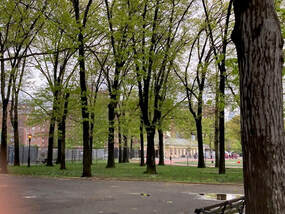|
One of the joys of guiding Forest Bathing walks is meeting people who feel a deep connection to parks and trees. It is in this capacity that I met Rita and John, who invited me to guide in East River Park this coming weekend and who, along with their community, are passionate stewards of East River Park and its trees. History Located on Manhattan's Lower East Side, East River Park is a beloved public green space that was established in the early 1900s as a way to provide a recreational area for the growing population of immigrants in the area. In the 1930s, the park underwent a major expansion, thanks in part to the Works Progress Administration (WPA), a New Deal program that provided employment opportunities for thousands of Americans during the Great Depression. The WPA oversaw the construction of new playgrounds, sports fields, and other amenities, as well as the planting of thousands of trees and shrubs. It is many of these very same trees that recently have been cut down in connection with a redevelopment initiative. Some are still standing - 80+ year old oaks and plain trees - but too are to be cut down. They are marked with numbered, coin-like metal tags, like dog tags worn by soldiers going into battle, carrying an indicator of doom. Over the years, the park has continued to evolve and adapt to the changing needs of the community. In the 1960s and 70s, the park became a popular gathering spot for counterculture movements, with music festivals and political rallies drawing large crowds to the amphitheater and surrounding areas. Redevelopment In recent years, the park has faced a number of challenges, including threats from development and climate change. In 2018, plans were announced to overhaul the park as part of a $1.45 billion flood protection project, which has been met with controversy and opposition from community members and activists. The project, known as the East Side Coastal Resiliency (ESCR) plan, aims to protect the surrounding neighborhoods from flooding in the event of a major storm. The plan includes building a flood wall and raising the elevation of the park by several feet. One of the most controversial aspects of ESCR is the impact it will have on the park's trees and the people who value their pesence. The plan calls for the removal of more than 1,000 mature trees, some of which are over 100 years old, to make way for the construction of a flood wall and raised parkland. This has been a major point of contention for park advocates, who argue that the trees are an essential part of the park's ecosystem and a vital source of shade, clean air, and wildlife habitat. In addition, the removal of so many trees would have a significant impact on the park's aesthetics, changing the character of the space and removing an important element of its history. To address these concerns, the city proposed a replanting plan that includes the planting over 2,000 new trees, as well as shrubs and grasses. However, critics argue that the new trees will take years to grow to maturity and will not provide the same benefits as the old-growth trees that are being removed. The impact of the redevelopment plan on the trees also raises broader questions about the value of urban green spaces and the trade-offs involved in urban planning. While flood protection is a critical issue for the city, the removal of so many trees from a beloved public park raises questions about the priorities of city officials and decision making considerations. Tree Neighbors Several individual trees in the park that have become well-known and beloved by locals over the years. Alarge copper beech tree near the park's southern entrance estimated to be over 150 years old has affectionately been nicknamed by locals as "Old Man," and it has become a cherished symbol of the park's history and continuity. Another notable tree in the park is a large sycamore that stands near the amphitheater. This tree, known as the "Pirate Tree," has a distinctive split trunk that resembles a pirate ship's bow. It has become a popular spot for children to play and climb, and it is often decorated with homemade pirate flags and other treasures. Another notable tree was referred to as the "Mother Tree" by some locals. A large cottonwood, it stood near the amphitheater and was estimated to be around 80 years old. The Mother Tree was a beloved feature of the park and was known for its massive size and distinctive shape. It provided shade and shelter to park-goers and was a popular spot for picnics and gatherings. Unfortunately, the Mother Tree was among the trees that were slated for removal as part of the ESCR plan. Its removal was a significant blow to the community, and many residents and activists protested the decision. In response to the outcry, the city pledged to preserve a portion of the Mother Tree's trunk and incorporate it into a new seating area near the amphitheater. The loss of the Mother Tree underscores the importance of preserving and protecting urban green spaces and the connections that people form with the natural world around them.
0 Comments
Leave a Reply. |
About this Blog
Hi! I'm Nancy Kopans, founder of Urban Edge Forest Therapy. Join me on an adventure to discover creative ways to connect with nature in your daily life, ways that are inspired by urban surroundings that can reveal unexpected beauty, with the potential to ignite a sense of wonder. Archives
April 2023
Categories
All
|



 RSS Feed
RSS Feed